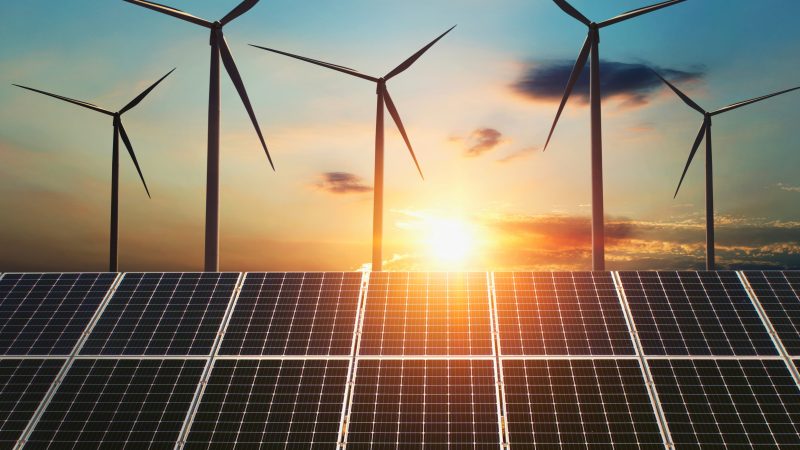Record additions of new wind and solar in 2022 helped Europe survive a “triple crisis” created by restrictions on Russian gas supplies, a dip in hydro caused by drought and unexpected nuclear outages, the analysis says.
Around 83% of the dip in hydro and nuclear power was met by wind and solar – and falling electricity demand. The rest was met by coal, which grew at a slower pace than some had expected amid a drop in fossil fuel supplies from Russia.
Solar generation across the EU rose by a record 24% in 2022, helping to avoid €10bn in gas costs, according to the findings. Some 20 EU nations sourced a record share of their power from solar, including the Netherlands, Spain and Germany.
Wind and solar growth is expected to continue this year, while hydro and nuclear generation is likely to recover. As a result, fossil fuel power generation could drop by an unprecedented 20% in 2023 – double the previous record observed in 2020, the analysis projects.
 The new landmark reflects both record growth in wind and solar in Europe and an unexpected dip in nuclear power in 2022.
Last year, Europe faced a “triple crisis” for its energy supplies, the report says.
The first driver was Russia’s invasion of Ukraine, which sent shockwaves through the global energy system.
Before the attack, Europe sourced a third of its gas from Russia. But the outbreak of war saw Russia restrict gas supplies to Europe and new EU sanctions on oil and coal imports from the country.
Despite the upheaval, EU gas generation remained stable in 2022, when compared to 2021.
This is largely because gas was already more expensive than coal in most of 2021, says analysis lead author Dave Jones, head of data insights at Ember. He tells Carbon Brief:
The new landmark reflects both record growth in wind and solar in Europe and an unexpected dip in nuclear power in 2022.
Last year, Europe faced a “triple crisis” for its energy supplies, the report says.
The first driver was Russia’s invasion of Ukraine, which sent shockwaves through the global energy system.
Before the attack, Europe sourced a third of its gas from Russia. But the outbreak of war saw Russia restrict gas supplies to Europe and new EU sanctions on oil and coal imports from the country.
Despite the upheaval, EU gas generation remained stable in 2022, when compared to 2021.
This is largely because gas was already more expensive than coal in most of 2021, says analysis lead author Dave Jones, head of data insights at Ember. He tells Carbon Brief:
 Some 20 EU countries sourced a record share of their power from solar in 2022. The leader was the Netherlands, which produced 14% of its power from solar – overtaking coal for the first time.
Elsewhere, Greece ran solely on renewables for five hours in October 2022, according to Ember. The country is also expected to reach its 2030 solar capacity target of 8GW by the end of this year – seven years early.
Some 20 EU countries sourced a record share of their power from solar in 2022. The leader was the Netherlands, which produced 14% of its power from solar – overtaking coal for the first time.
Elsewhere, Greece ran solely on renewables for five hours in October 2022, according to Ember. The country is also expected to reach its 2030 solar capacity target of 8GW by the end of this year – seven years early.
 Jones adds that the findings show that the energy crisis has “undoubtedly sped up Europe’s electricity transition”. He says:
“Not only are European countries still committed to phasing out coal, they are now striving to phase out gas as well. Europe is hurtling towards a clean, electrified economy and this will be on full display in 2023. Change is coming fast, and everyone needs to be ready for it.”
Jones adds that the findings show that the energy crisis has “undoubtedly sped up Europe’s electricity transition”. He says:
“Not only are European countries still committed to phasing out coal, they are now striving to phase out gas as well. Europe is hurtling towards a clean, electrified economy and this will be on full display in 2023. Change is coming fast, and everyone needs to be ready for it.”
Record renewables
Wind and solar generated a record 22.3% of EU electricity in 2022, for the first time overtaking nuclear (21.9%) and gas (19.9%), according to the analysis and shown in the chart below. It comes after wind and solar overtook hydro power in 2015 and coal in 2019. The new landmark reflects both record growth in wind and solar in Europe and an unexpected dip in nuclear power in 2022.
Last year, Europe faced a “triple crisis” for its energy supplies, the report says.
The first driver was Russia’s invasion of Ukraine, which sent shockwaves through the global energy system.
Before the attack, Europe sourced a third of its gas from Russia. But the outbreak of war saw Russia restrict gas supplies to Europe and new EU sanctions on oil and coal imports from the country.
Despite the upheaval, EU gas generation remained stable in 2022, when compared to 2021.
This is largely because gas was already more expensive than coal in most of 2021, says analysis lead author Dave Jones, head of data insights at Ember. He tells Carbon Brief:
The new landmark reflects both record growth in wind and solar in Europe and an unexpected dip in nuclear power in 2022.
Last year, Europe faced a “triple crisis” for its energy supplies, the report says.
The first driver was Russia’s invasion of Ukraine, which sent shockwaves through the global energy system.
Before the attack, Europe sourced a third of its gas from Russia. But the outbreak of war saw Russia restrict gas supplies to Europe and new EU sanctions on oil and coal imports from the country.
Despite the upheaval, EU gas generation remained stable in 2022, when compared to 2021.
This is largely because gas was already more expensive than coal in most of 2021, says analysis lead author Dave Jones, head of data insights at Ember. He tells Carbon Brief:
“There was no further gas-to-coal switching possible in 2022.”The other major contributors to the crisis were dips in supplies of both nuclear and hydro power, the report explains: “A one-in-500 year drought across Europe led to the lowest level of hydro generation since at least 2000, and there were widespread unexpected French nuclear outages just as German nuclear units were closing.”
This created a gap in generation equal to 7% of Europe’s total electricity demand in 2022, the report says.Around 83% of this gap was met by wind and solar generation – and a fall in electricity demand. (Electricity demand fell by 8% in the last quarter of 2022 compared to 2021 – driven by a combination of mild weather and public efforts to reduce energy use, according to Ember.) Solar generation increased by a record 24% in 2022, helping to avoid €10bn in gas costs, according to Ember. This was due to record installations of 41 gigawatts (GW) in 2022 – nearly 50% more than was added in 2021. From May to August, solar provided 12% of the EU’s power – exceeding 10% for the first summer in history.
 Some 20 EU countries sourced a record share of their power from solar in 2022. The leader was the Netherlands, which produced 14% of its power from solar – overtaking coal for the first time.
Elsewhere, Greece ran solely on renewables for five hours in October 2022, according to Ember. The country is also expected to reach its 2030 solar capacity target of 8GW by the end of this year – seven years early.
Some 20 EU countries sourced a record share of their power from solar in 2022. The leader was the Netherlands, which produced 14% of its power from solar – overtaking coal for the first time.
Elsewhere, Greece ran solely on renewables for five hours in October 2022, according to Ember. The country is also expected to reach its 2030 solar capacity target of 8GW by the end of this year – seven years early.
No role for coal
As countries scrambled to replace fossil fuels from Russia in early 2022, several EU nations signalled that they were considering increasing their dependence on coal-fired power. However, the new report finds that coal played a minimal role in helping the EU tackle its energy crisis. Just a sixth of the fall in nuclear and hydro in 2022 was met by coal, according to the analysis. And in the final four months of the year – as temperatures began to drop – coal generation fell by 6%, when compared to the same period in 2021. This was primarily driven by falling electricity demand, the report says. It adds that the 26 coal units brought back as emergency standby ran at just 18% capacity in the final four months of 2022. Nine of the 26 coal units did not provide any generation at all. Overall, coal generation rose by 7% in 2022 compared to 2021, increasing EU power sector emissions by nearly 4%. The report says:“It could have been much worse: wind, solar and a fall in electricity demand prevented a much larger return to coal. In context, coal’s rise was not substantial: coal power remained below 2018 levels and added only 0.3% to global coal generation.”
2023 outlook
The growth of wind and solar is projected to continue this year, according to industry estimates, the report says. At the same time, both hydro and nuclear power are expected to recover – with EDF forecasting that many of its French nuclear plants will come back online in 2023. As a result of these factors, fossil fuel power generation could drop by an unprecedented 20% in 2023 – double the previous record observed in 2020, the analysis projects. The report says:“Coal generation will fall, but gas generation, which is expected to remain more expensive than coal until at least 2025, will fall the fastest.”The chart below demonstrates how growth in wind and solar – as well as a continued fall in electricity demand – could prompt fossil fuel generation to fall in 2023.
 Jones adds that the findings show that the energy crisis has “undoubtedly sped up Europe’s electricity transition”. He says:
“Not only are European countries still committed to phasing out coal, they are now striving to phase out gas as well. Europe is hurtling towards a clean, electrified economy and this will be on full display in 2023. Change is coming fast, and everyone needs to be ready for it.”
Jones adds that the findings show that the energy crisis has “undoubtedly sped up Europe’s electricity transition”. He says:
“Not only are European countries still committed to phasing out coal, they are now striving to phase out gas as well. Europe is hurtling towards a clean, electrified economy and this will be on full display in 2023. Change is coming fast, and everyone needs to be ready for it.” Original article – https://www.carbonbrief.org/wind-and-solar-were-eus-top-electricity-source-in-2022-for-first-time-ever/



